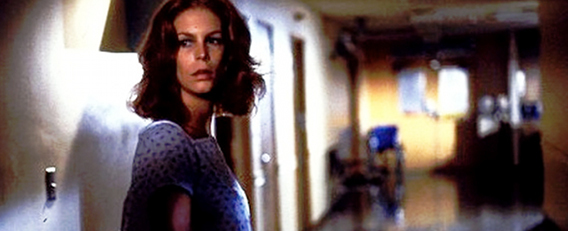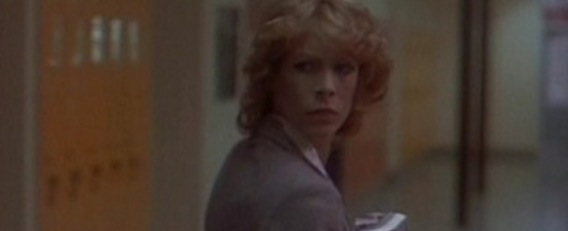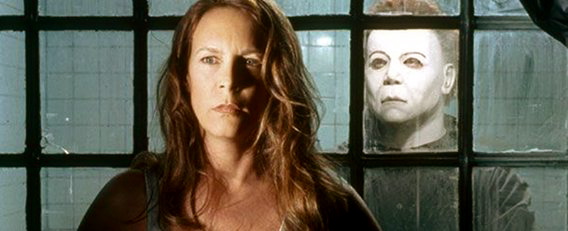
Whilst they no doubt launched her career and horror fans may still consider them amongst the best work that she has done, when Jamie Lee Curtis first entered the movie industry with a string of low budget slasher films critics were less-than-enthusiastic about her performances, whilst Curtis herself expressed frustration at having to play the same role over and over again. In their review of the 1980 thriller Prom Night, the New York Times stated that Curtis, “is a very stylish presence in this kind of movie, though she is a little too poised to be completely believable as the teen-ager she plays.” Opinions were a little more harsh towards her role in the far superior Terror Train, released the same year, with Variety commenting that, “Her acting fits a narrow groove.” In his review of the same movie, noted film critic and notorious slasher detractor Roger Ebert mused, “At this point in her career, if she should get a straight role in a conventional movie, she might start screaming and running away from the camera just on reflex.”
Curtis was always the first to admit that she owed her career to Halloween. John Carpenter’s stylish thriller had become the surprise success of 1978 and would ultimately pave the way for the subsequent slasher boom of the early 1980s (although it would be Friday the 13th two years later that would be the main instigator). Prior to landing the role of teen heroine Laurie Strode, Curtis had worked on Operation Petticoat, a small screen spinoff of a 1959 comedy that had starred her real-life father, Tony Curtis. Although she had not been Carpenter’s first choice, the fact that her mother was Psycho icon Janet Leigh and the director was an admirer of Alfred Hitchcock no doubt played a small role in his casting decision. Whilst Curtis had no expectations of any kind of impact on her career from the low budget thriller, she became an overnight sensation and before long was inundated with countless scripts for similar types of movies.
“In a horror film you start out usually very normal, like a normal person, and then you end up being a terrorised individual,” explained Curtis during the 1980 documentary Fear on Film: Inside the Fog, regarding the challenges of starring in a genre picture. “So you have all this range to play; you go from sad to happy, crying, hysterical – your smarts come back in; determination, bravery. And all those things come into a horror film if you’re the person who inevitably gets terrorised. So it enables you to show your stuff in a very broad sense.” Curtis would become the archetypal final girl with her performances as the resourceful heroine in Carpenter’s Halloween and The Fog, as well as the relatively successful slasher films Prom Night and Terror Train. Although she could easily have made a career out of recycling the same role in each film, Curtis was determined to break free from the constraints of the horror genre and branch out into more respectable and commercial territory.
Thus, at the age of twenty-four, Curtis entered the mainstream as the hooker with a heart of gold in the Eddie Murphy blockbuster Trading Places. A far cry from the virginal heroine of Laurie Strode, Curtis’ role in the movie would see her appear topless for the first time in her career, which would later be referenced in the post-modern slasher Scream with one character declaring, “Jamie Lee was always a virgin in horror movies. She didn’t show her tits ’til she went legits.” But during her earlier period of horror films, where she would earn the label ‘scream queen,’ Curtis proved to be one of the strongest and resourceful heroines of the genre, providing a template that Friday the 13th‘s Adrienne King, A Nightmare on Elm Street‘s Heather Langenkamp and all other slasher final girls would follow. Whether she liked it or not, she had left a prominent mark on the horror genre and would spend the following decade attempting to break from its typecasting.
“I wear my Halloween pin with great pride, y’know,” admitted Curtis in the documentary Halloween Unmasked 2000, in which the cast and crew looked back at the making of the first movie over two decades later. “I tried very hard through twenty-two-now years of making movies to always hold up Halloween and say, y’know, “A – It was the best experience I ever had. It was by far, up until True Lies, the best part I ever had.” Y’know, I try to point out the irony that in those exploitation movies I was intelligent, forthright, fought back against adversity and was the lead in those movies for that role.” But the films that would follow in the wake of Halloween‘s surprise success would see Curtis typecast as the reluctant heroine and would provide little in the way of new material, forcing the young actress to play variants of Laurie for the next few years. The first of these would be Prom Night, a Toronto-shot thriller that featured one of the last serious performances from Leslie Nielsen, now most known for his comedic turns in Airplane! and The Naked Gun.

“Jamie Lee Curtis’ manager came to us,” explained director Paul Lynch in Going to Pieces: The Rise and Fall of the Slasher Film on how Curtis became involved in the movie. “And I couldn’t get over it the day he called, ’cause I’m thinking, “It’s Jamie Lee Curtis, she was in Halloween. She’s done this! Why? Why?”” Curtis would later regret her involvement in Prom Night, citing it as the worst of her earlier horror pictures. During an interview with Fangoria around the release of Halloween II in 1981, Curtis admitted, “I hated Prom Night… I had only made two movies up to that time, they offered me three times the money I was paid on The Fog, and it was the first role that was actually offered to me; I didn’t even have to read for it… I’ll let you know something, all that psychopathic killer stuff was not in the original script, not in the script I agreed to do. They added that after they cut the movie. I’m very angry about that because I feel I wouldn’t have made the movie had it been a remake of Halloween – which is exactly what they were trying to do.”
Curtis’ next picture, Terror Train, saw her once again shooting in Canada, although this time it would be Montreal in Quebec. Whilst Curtis would consider the movie a step up from Prom Night, she had grown weary of the horror genre and was desperate to escape. Relocating to Australia for a short time to shoot the thriller Roadgames would come as a welcome change of pace and an attempt to take on a different type of role, although the New York Times’ review of the movie would describe her character as merely a ‘jiggly hitchhiker.’ Reluctantly, Curtis returned the role that had made her famous with the highly anticipated sequel Halloween II, which would prove to be a troubled affair due to Carpenter suffering from a bad case of writer’s block. In his review of the movie, Ebert joked, “The plot of Halloween II absolutely depends, of course, on our old friend the Idiot Plot which requires that everyone in the movie behave at all times like an idiot… So Jamie Lee Curtis and other young women consistently run into traps where the killer can corner them.”
“The heroine of such horror flicks as The Fog, Prom Night and Terror Train has traded in her bucket of blood for a skintight bathing suit and dyed blonde hair,” revealed a small news article in a September 1981 issue of Weekly World News, as Curtis had announced her retirement from the horror genre. Over the following decade, Curtis would enjoy various success in movies ranging from comedy (A Fish Called Wanda) and action (True Lies) to thrillers (Blue Steel) and drama (Forever Young). Yet, to everyone’s surprise, as the twentieth anniversary of the original Halloween approached, Curtis began to express interest in a new sequel. There had been four further installments in the Halloween franchise since her last appearance, although Halloween III had little connection to those that would follow. Even though Curtis had spent over fifteen years distancing herself from the slasher genre and the roles that had initially made her famous, the thought of returning to the character of Laurie as an adult was too tempting.
“The only reason I’m back is that this story is taking all the previous Halloween movies to task,” Curtis would tell Fangoria shortly before Halloween H20‘s release in 1998. “We’re showing that Laurie Strode did not go off after the events of the first two movies and live a life unscathed by the horror she experienced.” She would also comment on the sequels that she had missed out on and how they related to the atmosphere generated by both Carpenter’s original and Steve Miner’s H20, which she considered the true successor to Halloween II. “This is the day. But as the day ends and the night comes, we get that sense of fear approaching. It’s that expectation that made the first Halloween so great, and it’s a big part of why the sequels all pretty much sucked.” Even though Curtis saw H20 as a chance to lay the franchise to rest once and for all, in true slasher fashion Halloween returned four years later, in which Laurie Strode would finally meet her demise.
Reuniting with Halloween II director Rick Rosenthal, Halloween: Homecoming (later retitled Resurrection) would alienate most of the fans who had loyally flocked to see H20 at the cinemas and would prove to be a disappointing conclusion to the original series. It would seem ironic that Curtis would return for not one but two Halloween sequels, after managing to achieve her initial goal of escaping the franchise and the horror genre in general. Regarding her horror legacy and the slasher movies she had participated in, Curtis once told Fangoria, “I don’t want people to think I don’t like ‘em, or make it sound like I didn’t enjoy doing them, or that it was an awful experience all the time. I owe them all a lot, and I’m very proud to have participated in them.”


7 Responses to How Did Jamie Lee Curtis Really Feel About Slasher Movies?